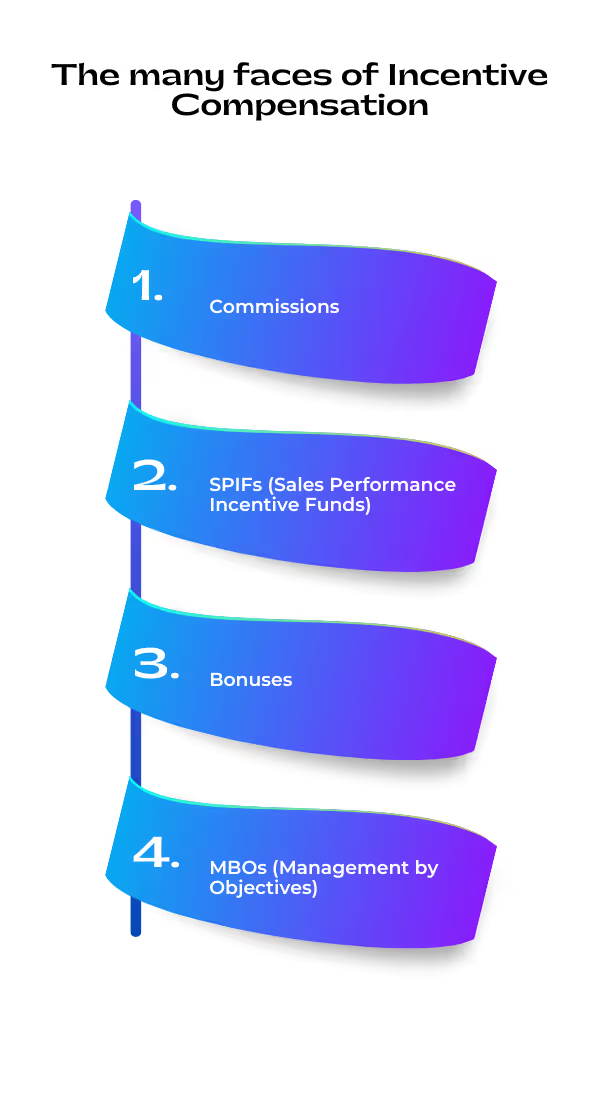
Blog
The Ultimate Guide to Sales Compensation for 2023!
January 19, 2023


Key Insights
This is the truth: Your salespeople are the pivot around which the future of your company revolves. Are you still asking yourself why it is important to keep them happy? The answer is actually quite simple. People like to be acknowledged and rewarded for their hard work. It is easy for sales managers to assume that their reps are satisfied with their compensation. But here is a cold hard fact - 78 percent of workers responded to a Globoforce survey by saying that they would work harder if they felt that their efforts were better recognized and appreciated.
The sales manager's most potent tool, and simultaneously the most challenging to implement, is the sales compensation plan. Incentive pay is particularly impactful as it can significantly drive improved business outcomes by creating a framework that treats salespeople as if they were company owners! What this means is that by giving reps a slice of the company’s revenue that they help generate, you can make them feel happier and more invested in the company’s growth. Wondering how to tailor your Incentive Compensation plan? We've got you covered by breaking down the complexities of Incentive Compensation into these easy-to-follow steps, including real-life scenarios and sales deck examples that illustrate successful implementation.
Here’s the looming question that you may be struggling with: How do you lay out an Incentive Compensation plan that works for your key contributors? Don’t worry! We opened this Pandora’s Box for you by breaking down the complexities of Incentive Compensation into these easy-to-follow steps.
Much Ado About Nothing- What is Incentive Compensation, afterall?
Incentive Compensation is basically performance-based compensation – exclusive of the base salary that a rep might receive – and is directly connected to the reps’ goals and milestones. A good Incentive Compensation plan will tell the rep in clear terms what they need to do in order to earn more. By setting clear and realistic goals for sales reps, an IC plan drives them towards profitability, while also promoting a sense of unity and motivation through fair and equitable broad based compensation across the entire sales team.
If you are still wondering whether laying out your company’s goals clearly and communicating them with your sales team makes a difference, then this study from Mckinsey is for you: When a company challenged one of their teams with a clear goal to achieve a $40 million target in 40 days, the team not only hit the mark, but crossed the mark several days in advance.
Success stories like these are the reason why incentives are becoming an increasingly popular way to motivate salespeople and keep them on track.
The many faces of Incentive Compensation

Good News- Your sales team is successfully hitting targets! Now how do you hand over the Incentive envelope? What kind of incentive would push your reps to perform even better?
These four types of incentives are probably your best bet-
- Commissions- The first card from the deck! Commissions are the most common when it comes to handing out incentives.
Some commissions like Straight Commissions are quite easy to understand and manage- A sales rep is paid a pre-decided percentage of the revenue generated from every deal that they close. While others like Residual Commissions - where a sales rep continues to receive a percentage of the revenue generated as long as the client remains associated with the company - are more complex and need a multitude of resources in order to be managed properly, especially when considering their impact on OTE in compensation structures.
- SPIFs (Sales Performance Incentive Funds)- SPIFs are like a trick down the sleeve that companies can use to see results immediately. They are basically short-term incentives that can be used when a company wants to increase sales volume for a short period. They are also highly effective when a company is introducing a new product. Imagine a company launching a new product. They may give their sales reps a certain amount after each sale or after they reach a set target. This way attention can be directed to that product in the short term.
- Bonuses- Bonus payments have survived the test of time. They are essentially fixed amounts paid to reps when they reach specified targets. They can be paid on a monthly, quarterly, bi-annual and annual basis depending on the organization’s goals. Some companies also give bonuses to entire departments in order to achieve broader goals.
- MBOs (Management by Objectives)- This system of incentives is aimed at making reps a part of the decision making process. The idea is to get the managers and employees to collaborate and set collective goals. The managers work on streamlining each individual's KPIs and make sure that larger company goals are met by ensuring that each rep performs at an optimal level.

Expected outcomes are clearly stated. Some examples could be-
- Cut costs
- Increase sales
- Work for customer acquisition
IC vs ICM: The woes of the three Ws
Understanding Incentive Compensation does not immediately translate into an Incentive Compensation plan. Incentive Compensation Management is a different ball game altogether! To put it simply, ICM is the strategic process of creating and implementing an incentive plan that works. For instance, an IC plan built for success will ideally-
- Improve your forecasts
- Align rep behavior with your company’s goals
- Empower your reps to earn more and provide them upward mobility
- Contribute to better customer interaction and service
- Reward top performers
Saying that it is difficult to create a plan that potentially leads to these outcomes would be an understatement.
If you have taken on the herculean task of designing your company’s IC plan, you may find yourself in a conundrum. Organizations today are diverse, to say the least. So are their IC plans and pay philosophies. There is no ‘one size fits all’ compensation plan that sales leaders can pick off the shelf, and customization is key.
A growth leader should start the process by asking themselves three very important who, what and why questions.
Who is getting the incentive?
One common myth about Incentive Compensation is that it is a system that only rewards individuals, when in reality profits can be shared with-
- Individuals – Incentives can be a part of their structured pay.
- Sales teams and departments – Incentives could be rolled out when they succeed in hitting shared targets.
- Channel Partners – Incentives to distributors, affiliates and vendors when they reach goals.
Decide who will be the primary beneficiaries of the Incentive Compensation plan, and consider incorporating the Sales Mix Calculator to refine your approach.
What will the incentive be?
What does incentive mean to your reps? What is it that they would really like to get when they achieve their goals? Is it money? Or is it non-monetary incentives like a paid vacation or office trips?
Another crucial factor to consider when optimizing the Pay-mix Ratio is the implementation of individual incentive plans. By designing personalized incentive structures based on individual performance, sales reps can be motivated to achieve specific goals that align with the company's objectives. These incentive plans can include commission structures, bonuses for meeting or exceeding targets, or performance-based rewards that recognize exceptional sales achievements. Implementing individual incentive plans in conjunction with the Pay-mix Ratio can create a powerful combination that fosters a results-driven sales culture and propels the organization towards long-term success. To learn more about how individual incentive plans can contribute to the overall effectiveness of the Pay-mix Ratio, check out our blog, "A Crafty Concoction: The Pay-mix Ratio!"
Why are you giving these incentives to your employees?
Ask yourself what you want the outcome of your incentive to be. Is it to get new leads or is it retaining customers? Do you want your employees to specifically focus on one recently launched product or do you instead want them to focus on clearing the stockpile of a discontinued product?
How much do you know about channel partner incentive program? Check Channel Partner Incentives: Benefits, Types, and Best Practices Channel Partner Incentives: Benefits, Types, and Best Practices for a comprehensive read.
Deconstructing the Dilemma: Four easy-to-follow steps for ICM bliss!
Yes, it is a little bit terrifying to look at all the intricate web that is IC. With so many factors for you to consider, you may be wondering what the first step is. Don’t worry, we got you!
A phased approach to ICM would entail -
- A Design Phase
- A Consultation Phase
- An Implementation Phase
- An ongoing Adjustment Phase
Let’s try to understand each of these phases in detail.
A toppling House of Cards
Given that compensation is the largest component of any organization’s total labor costs– around 70% – , one can draw the logical conclusion that businesses spend a lot of time and resources perfecting it. Here’s the reality! They don’t. ICM as a subject of study is still developing: Best practices are yet to be established.
This study done by Deloitte’s is an eye-opener: According to the 2020 Global Human Capital Trends survey, 56 % of the organizations felt the need to redesign their compensation strategy in the last three years because their plans couldn't keep up. 64% are in the process of redesigning the strategy as we speak. 69 % of organizations have stated that the changing nature of compensation expectations and strategies is “important” or “very important” to their success and growth over the next 12 to 18 months. However, only 9 percent report being “very ready” to address this trend.
The summary – Organizations are struggling to design, implement and manage a working IC plan!
Designing Incentive Compensation Management System
Growth leaders need to understand their company’s unique pay philosophy and try to create plans that align with the organization’s-
- Value systems
- Goals
- Employee needs
Always remember that a plan that works for one organization may not work for you! Even so, it is also important to understand that some rules need to be followed in order to cook up the perfect IC recipe. The the fundamental principles that you should keep in mind while crafting your plan are-
- Organizational Principles-
These refer to the strenuous task of aligning your plan with your company’s expectations. Some questions that you should ask are-
- How do you define success? State clearly what your idea of success is.
- Then, ask if you can quantify your idea of success so that your reps can understand what they are working towards?
- Can you ensure that the targets you have set align with the organization’s goals?
The answer to these questions - KPIs or Key Performance Indicators. These are your indicators for success and the north star for your employees. Experts suggest that KPIs should be limited to three. Another commonly accepted suggestion is that each KPI should at least be 15% of the total incentive target in order to keep your reps focused on what matters. Make sure that the KPIs you set are SMART-
- Specific
- Measurable
- Achievable
- Realistic
- Time-based
- Motivational Principles -
No two salespeople are the same. Therefore, it is not difficult to fathom that they will be motivated in different ways. A compensatory analysis might show that a new hire may be driven by commissions he gets from each sale while a veteran salesperson may be driven by the bonus he gets after hitting the set quotas. Ask your employees-
- Are they happy with the compensation that are currently being offered?
- What drives them? Is it more recognition, more money or more flexibility? Give the incentive a face.
When reps are directly involved in the decision making process, they are bound to feel valued. So, ask them even if you know. You may just be surprised!
You plan should take into consideration these variations among reps-
- Seniority
- Department
- Skill
- Behavioral Principles -
In order to understand Behavioral Principles, you must ask if-
- Will your reps deliver against your plan?
- Should team behavior be rewarded? If yes, then to what extent?
- Is your plan simple and understandable?
Because ‘understandable’ is a highly subjective term, it would help to look at this checklist of behavioral principles put together by The Society for Human Resource Management and consultant Aubrey Daniels . Your plan should be-
- Objective
- Transparent
- Understandable
- Proactive
- Comprehensive
- Regular
- Consistent
- Aware
Consulting with your stake holder

Talk to all relevant stakeholders. Present your plan and actively seek feedback from-
- Your reps- Merely familiarising yourself with your team members’ names and faces will not cut it. You need to actively engage with them on a daily basis to understand how they approach sales. Make it a point to talk to your team members about their selling styles, weaknesses, and strengths. Have a sit down with your team members in order to make them a part of this process. These sessions will help foster a two-way trust between you and those you lead resulting in a more transparent and ultimately more productive IC plan.
- Your counterparts from other departments- Being a lone wolf will not take you anywhere! Work in close collaboration with other departments, especially marketing and customer service. This inter-department approach will provide your team with the opportunity to understand your customer more intimately and consequently create a better plan.
- Your channel partners- Channel partners are important! There is no reason to exclude them from an IC plan. Talk to your channel partners about how they view compensation.
Armed with all this feedback, create a plan that works for all stakeholders.
Implementing your ICM
Implementation is perhaps the most daunting part of ICM. Making sure that the plan runs smoothly is no piece of cake and most managers struggle to keep up. However, it is not impossible to keep your IC plan healthy and running. Simple practices like these go a long way-
- Frequent and Accurate Reporting- Often, reports are made months after a financial year ends. And even when they are available, they are not audit-ready, making it hard for finance teams to work on them. It is therefore impossible for sales leaders to take bold decisions like changing their incentive compensation plans. This static approach can stifle business growth significantly. Sales leaders need to look at the macroscopic impact of inadequate reports and then make microscopic changes in the way data is collected and analyzed. Utilizing tools like the Kennect sales mix calculator can further enhance the precision of data analysis, ensuring informed decision-making for adjusting incentive plans.
Let’s be clear though - not all data is good data. Ask yourself these three simple questions to make sure that the data you are collecting is the perfect raw material for a successful plan-
- Do you have enough data?
- Is your data accurate and trustworthy?
- Is your data uniform?
Visit this blog – Big Data and a Big Question- Are you still relying on annual reports – to read more about the importance of frequent and efficient reports and why sales leaders should adopt a data-driven strategy to combat challenges.
- Ongoing communication with your reps- Your IC plan is ultimately tailored for the rep. Therefore, a good IC plan should be rep friendly and allow them to track their performance. It should also make it easy for them to know how much they are earning and what they need to do in order to earn better. Keep your reps in the loop. A good way to do that would be through live presentations, FAQ docs, and online resources like how-to videos. Additionally, consider incorporating updates on the efficiency of sales order management processes, ensuring your reps are informed about improvements in order processing and fulfillment.
Corrections and making adjustments to your Incentive programs
After a few months, when your plan has been operational for a few months, it is necessary to call upon the relevant stakeholders for a review and feedback session. Think of it like a postmortem! Questions like these need to be addressed-
- What worked with the design?
- Where did the design fail to hit the mark?
- What are some of the gaps in the process?
- Are your systems outdated or are they able to keep up with your plan?
A natural progression in your IC plan design is natural. With this ever changing business ecosystem, your plan is bound to change. Good plans will have the potential to adapt to changing company goals, product launches and new market practices.
Another key element to comp management success is an automated system that supports this cycle of feedback and can quickly incorporate those changes. If your organization uses spreadsheets or a homegrown system, ask yourself these questions to make sure that your solution is really automated and future-ready-
- Is your solution built for integrations across CRM, ERP and HRIS?
- Is your solution capable of change?
- Is it easy for your sales leaders and reps to interact with your solution?
- Can your solution incorporate incentives like bonuses, spiffs, and MBOs?
To learn more about how an automated Incentive Compensation Management solution can help you make better real-time strategic decisions, read this blog– ‘Automation v/s Automation: An Incentive Compensation Management Perspective’.
Red Flags: Incentive Pay Risks
No plan is perfect! However, it is possible to mitigate risks by keeping in mind these possible challenges-
- Employees tend to avoid doing activities that aren’t tied to incentives. To mitigate this risk, maintain a healthy Pay-mix ratio.
- Incentive possibilities might lead sales reps towards unethical behavior and practices. Clearly codify acceptable behavior and request your HR reps to ensure that it is followed.
- Rewards should not be affected by the management’s personal biases. Incentives should be solely based on KPIs.
- Incentives should not lead to over competition and jealousy between reps. Team building exercises will help with that.
Kennect: Your one stop solution for ICM Automation!
Kennect’s fully automated ICM solution leverages a data-driven approach to build, run and automate your incentive compensation plans to create transparency and achieve operational efficiency. Kennect helps you break the silos of your comp system by seamlessly integrating across CRM, ERP and HRIS.
With Kennect’s ICM solution, enterprises can use these features to take complete control of their comp plans-
- Intuitive & no-code plan builder that allows you to save up to 80% of the time that goes into building complex plans.
- Industry-first Commission Simulator that reps can use to plan their earnings by simulating their sales data and achieve real-time visibility.
- Kennect supports 100+ integrations to bring you to speed in no time.
- Interactive leaderboard that is easy to use and understand.
- Intelligent nudges based on sales compensation enable your employees to stay motivated & keep pushing their limits.
Book a demo with us today to learn more about how Kennect can help you navigate your ICM & Sales Performance Management
ReKennect : Stay ahead of the curve!
Subscribe to our bi-weekly newsletter packed with latest trends and insights on incentives.
Thank you! Your submission has been received!
Oops! Something went wrong while submitting the form.
Your data is in safe hands. Check out our Privacy policy for more info





%20(1).avif)

.avif)








